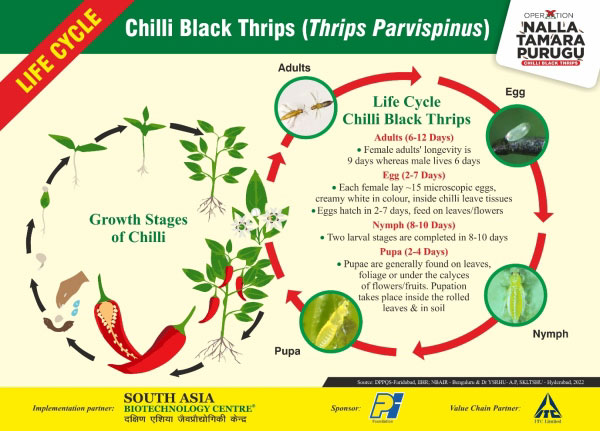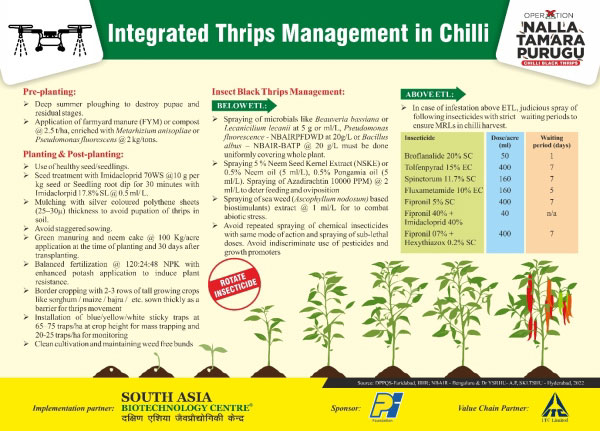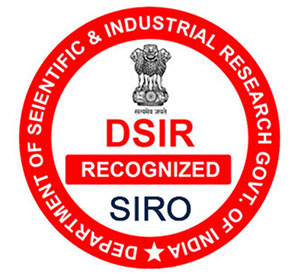Black thrips (Thrips parvispinus)
Black thrips (Thrips parvispinus)
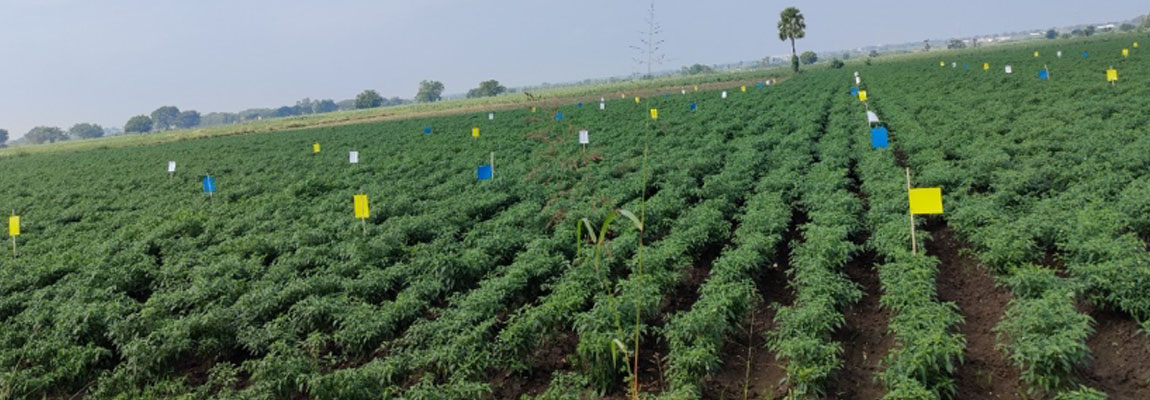
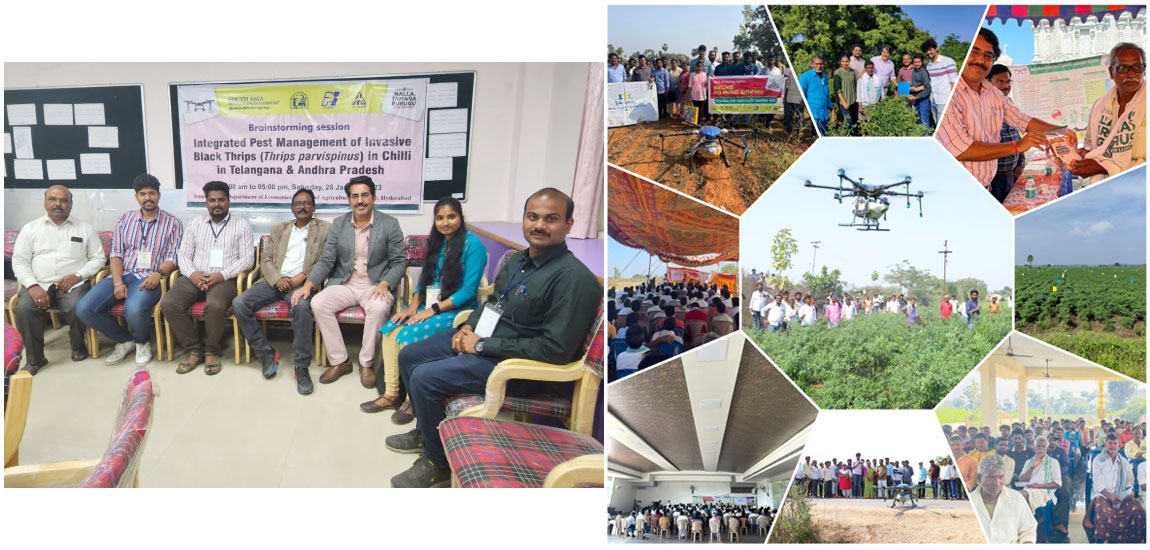
Chilli Black thrips- A devastating invasive pest
The devastating story of invasive Black thrips, Thrips parvispinus (Karny), polyphagous and devouring pest was found for the first time occurring on chilli, papaya, eggplant during 2015 in Karnataka state. The pest now is reported to not only occur but has been responsible for destruction of chilli crop in all chilli growing areas of Andhra Pradesh, Telangana, Karnataka, Assam, Chhattisgarh, Gujarat, Kerala, Maharashtra, Odisha and Tamil Nadu.
Now, the pest having been recorded in India is threatening the cultivation of Chilli in major chilli producing areas. The alarming situation since its appearance warranted quick remedial measures to manage and arrest its spread to newer areas bringing together the knowledge and expertise available to help the farmers and the country from earning precious foreign exchange. In the backdrop of severe pressure exerted by Black thrips on commercial cultivation of chilli crops, also a great concern to India in export of cut flowers, green leafy vegetables, fresh fruits and other vegetables. The relation between upsurge of T. parvispinus and diseases such as Anthracnose and Powdery mildew together needs to be studied, as thrips are known to predispose the fruits for secondary infection.
Importance of Chilli: Production and Export
Chilli is second largest crop after cumin grown over 7,28,627 hectares producing around 2 million tons across major chilli growing states of Andhra Pradesh (177,556 ha), Madhya Pradesh (116,618 ha), Karnataka (114,901 ha), Telangana (92,000 ha), Odisha (72,000 ha) and Tami Nadu (55,716 ha) respectively. Chilli is the largest exported spices accounts for 38% of the quantity of spices exported and 31% of the total foreign exchange earnings. Andhra Pradesh is the largest producer of chilli and contributes 38% to the total production in India. Guntur, Prakasam, Krishna and Kurnool constitute 92% of the major chilli producing istricts of AP. Guntur alone contributes to 15 % of total production in India.
Table 1. An overview of area and production of chilli in India - 2021-2022
| Chilli | Area (In Hectare) | ||
| All Spices 44,21,920 | Chilli 6,94,313 | % of India 15.7 | |
| All Spices 108,75,765 | Production (In Tons) Chilli 18,66,108 | % of India 17 |
Figure 1. Illustration of spices export from India, 2021-22
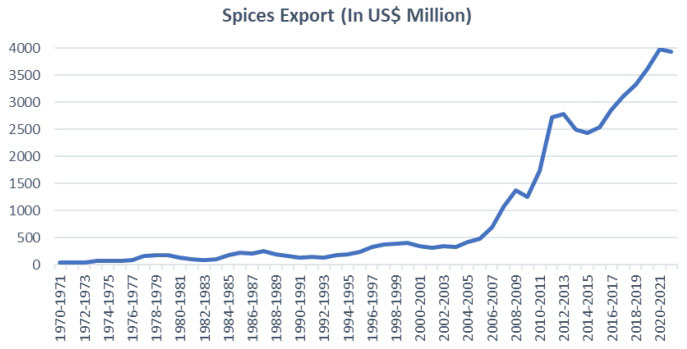
Figure 2. Contribution of chilli, in quantity and value, in total spices export - 2021
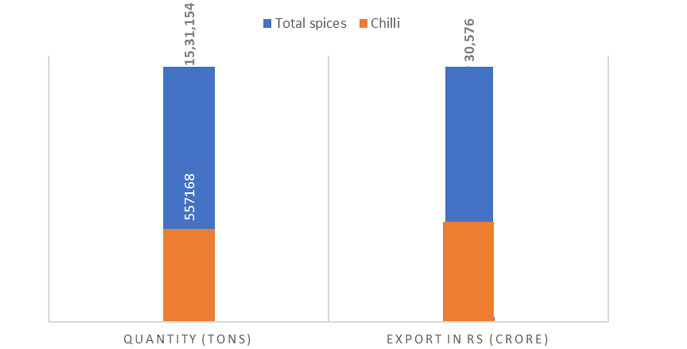
Source: Spices Board of India; Analysed by South Asia Biotechnology Centre, 2023
Distribution & Infestation of Chilli Black thrips
Invasive Black thrips or Thrips parvispinus (Karny), a polyphagous invasive pest infesting chilli, papaya, eggplant (brinjal) and pepper was found for the first-time feeding on papaya in 2015 in Karnataka. Notably, the invasive Black thrip was reported in chilli growing areas of Andhra Pradesh, Telangana and Karnataka for the first time in Rabi 2021- 22. From 2015, the pest has been found feeding on both agriculture, horticulture and ornamental crops and widely distributed across Andhra Pradesh, Assam, Chhattisgarh, Gujarat, Karnataka, Kerala, Maharashtra, Odisha and Tamil Nadu.
Black thrips feeds on tender flowers, causes large scale shedding of flowers, stunting and malformation of fruits and fruit drop in chilli, leading to severe yield loss. In absence of any approved effective biological and chemical control strategies, the pest has caused significant damage & yield loss and considerably reduced quality and income of chilli growing farmers in AP, Telangana and Karnataka. As a result, the prices of chilli have increased significantly taxing consumers and industry. NBAIR and DPPQS field survey reported the incidence of black thrips on flowers in alarming proportions, averaging 18-19 thrips per flower with potential to damage about 90 to 95% of flowers.
In 2021 season, Dr YSR Horticulture University's survey reported major infestation of T. parvispinus affecting almost 90% of total areas in Guntur causing a loss of Rs 1 lakh per acre. Furthermore, the survey reported yield loss due to this pest in Guntur district alone up to 85 to 100 % in severely affected areas forcing farmers to uproot at least 12% of total cropped area.
Given the devastating nature of chilli Black thrips, the Government of India's Directorate of Plant Protection Quarantine & Storage (DPPQ&S), Indian Council of Agricultural Research (ICAR), Indian Institute of Horticulture Institute (IIHR), State Agricultural Universities (SAU) and State Horticultural Universities (SHU) have worked in tandem to promptly devise strategies to mitigate the damage caused by Black thrips in chilli growing areas. Efforts were made at SAU, SHU, Krishi Vigyan Kendras (KVKs) and horticultural departments of chilli growing States to popularize the control measures and educate the farmers to deal with this invasive pest.
Figures 3. Package of practices (POP) issued by Central/ State Government, 2021-22
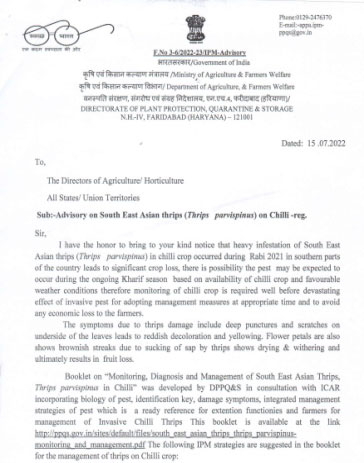
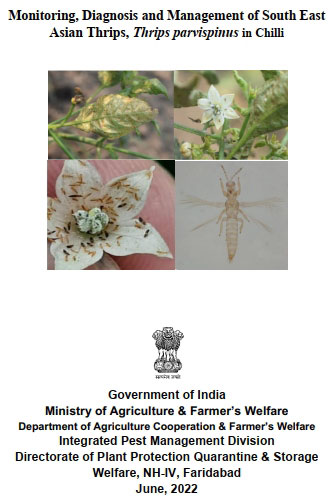
Pest Alert: Invasive thrips, Thrips parvispinus (Karny) threatening chilli cultivation in India
Thrips parvispinus (Kamy) is a cosmopolitan species of quarantine importance and has been reported from Thailand to Australia (Mound & Collins 2000). The last two decades witnessed a drastic extension in the geographic distribution of T. parvispinus and it is now known to occur in France, Greece, Hawaii, Mauritius, Reunion, Spain, Tanzania and Netherlands, besides India (Tyagi et al. 2015; NPPO 2019). In India, this species was first reported on Carica papaya L. (Caricaceae) in Bengaluru (Tyagi et al. 2015) and later on Brugmansia sp. (Solanaceae) and Dahlia rosea Cav. (Asteraceae) (Rachana et al. 2018; Roselin et al. 2021). It is a polyphagous pest, infesting beans, eggplant, papaya, pepper, potato, shallot and strawberry (NPPO 2019). It causes appreciable damage to different crops and to quote an example of yield loss due to T. parvispinus, an appraisal made on pepper reflected the crop loss of 23% under the field conditions of Indonesia (Johari et al. 2014). In addition, it inflicts injury to ornamentals viz. Anthurium, Chrysanthemum, Dahlia, Dipladenia, Gardenia and Ficus. Authors who have first reported the occurrence of T. parvispinus in India expressed concern about this pest on an economically important plant like papaya and also had an apprehension towards quarantine related issues. They emphasized the need for regular monitoring in other parts of India as it is likely to acquire the pest status.
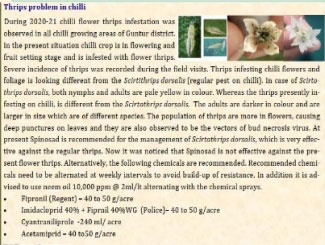
Operation Nalla Tamara Purugu
In addition, a mega project “Operation Nalla Tamara Purugu (Black thrips in Chilli)” was launched by South Asia Biotechnology Centre with the support of PI Foundation and ITC Ltd to engage key stakeholders including scientists, researchers, extension officials and farming community, laying out field demonstrations and educating chilli growing farmers about IPM and quality production practices including value chain development in Guntur, Prakasam, Krishna & East Godavari districts of Andhra Pradesh, and Khammam, Mahabubabad & Bhadradri Kothagudem districts of Telangana. Operation Nalla Tamara Purugu has been organizing IPM field demonstrations, intensive fieldoriented training programs, creating knowledge resources and deploying new cultural methods, microbials and innovative molecules to manage the devastating pest in the priority chilli growing areas of Andhra Pradesh and Telangana in Rabi 2022-23.
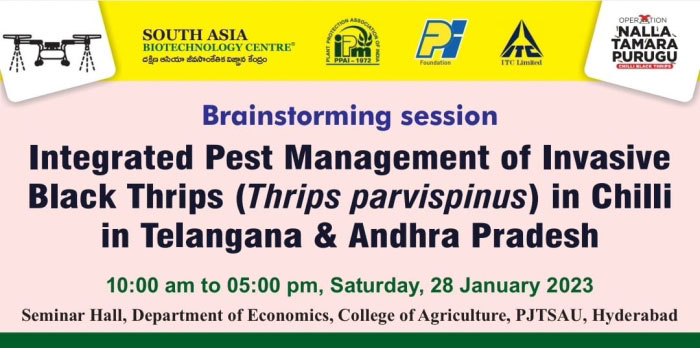
Brainstorming Session on Integrated Pest Management of Chilli Black thrips
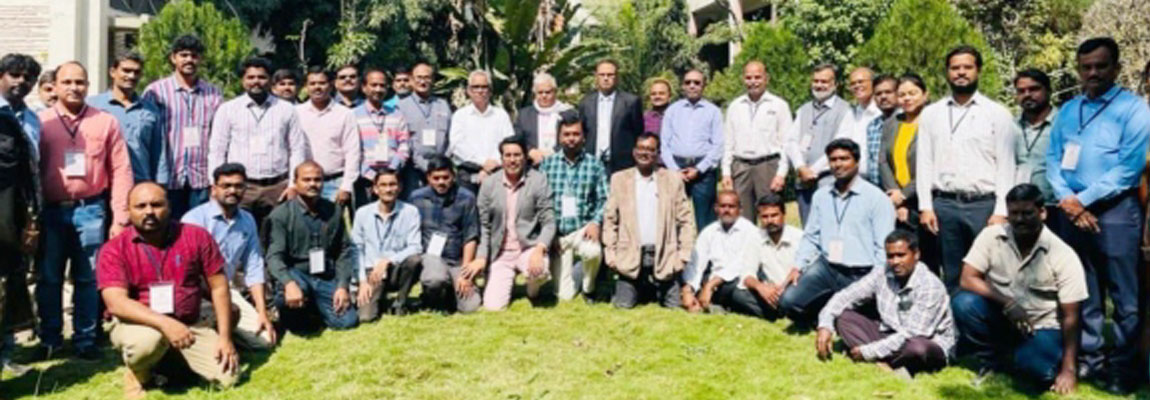
Inaugural Session:
The inaugural session was attended by the scientific fraternity from South Asia Biotechnology Centre, Jodhpur, Plant Protection Association of India, Hyderabad, International Organizations such as International Crops Research Institute for Semi-Arid Tropics (ICRISAT) and World Vegetable Centre, Hyderabad, SAUs viz., Professor Jayashankar Telangana State Agricultural University (PJTSAU), Hyderabad, Sri Konda Laxman Telangana State Horticultural University (SKLTSHU), Hyderabad, Vasanthrao Naik Marathwada Krishi Vidyapeeth (VNMKV), Parbhani and ICAR institutes such as Indian Institute of Horticultural Research (ICARIIHR), Bengaluru, Indian Institute of Oilseeds Research (ICAR-IIOR) and Indian Institute of Rice Research (ICAR-IIRR), Hyderabad, Private agencies viz, PI Industries, Gurgaon, BASF India, Mahyco Seeds Jalna, Sakata Seeds Bengaluru, Rythu Sadhikara Samstha (RySS), an AP Government supported corporation for farmers empowerment as well as few chilli farmers from AP and Telangana. Dr B Sarath Babu, President, Plant Protection Association of India welcomed the scientific gathering and deliberated on the objectives and intent of engaging key stakeholders in the brainstorming session on chilli black thrips. Dr C D Mayee, President of South Asia Biotechnology Centre, Jodhpur while addressing the delegates highlighted the significance and management of invasive, transboundary insect pests such as black thrips and fall armyworm and called on the scientific community to deal with the economic consequences of invasive pests in agriculture. He invited the experts to seriously investigate the pest dynamics and investigate it from all angles ranging from the pest biology, life cycle, host interactions, etiology and vector transmissions to disease epidemics. Dr B Venkateswarlu, Former Vice Chancellor, VNMKV, Parbhani cautioned the participants about the role of climate change and aberrations in weather for the flaring up of thrips populations and to formulate integrated approaches for its management. Dr R Jagadeeshwar, Director of Research, PJTSAU and Dr K S Varaprasad, Former Director, ICAR-IIOR further highlighted the concerns of invasive pest and proposed to reduce the use and risk of pesticides. Dr Anand Kumar, Former Director, ICARNRCPB invited the stakeholders to look for innovative solutions such as application of biotechnology to manage the invasive pest. He elucidated the example of Bt Cry 51 event and use of Bt as bio pesticide to control thrips in northern America. Dr Rayudu, IAS (Retd.) reiterated development of holistic approach of pest management focusing on cropping system, inter cropping, crop rotation and deployment of microbial bio control agents. The inaugural session concluded with suggestions for stakeholders to i). monitor the effect of climate change on pests and diseases ii). develop eco-friendly and sustainable pest management packages for tackling the thrips menace in chillies and iii). form an interdisciplinary team of scientists to provide immediate solutions for the benefit of farming community.
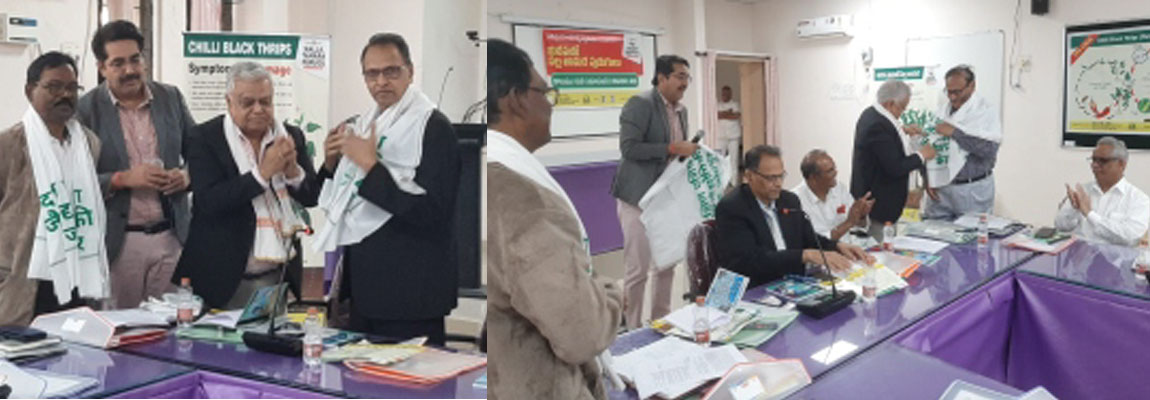
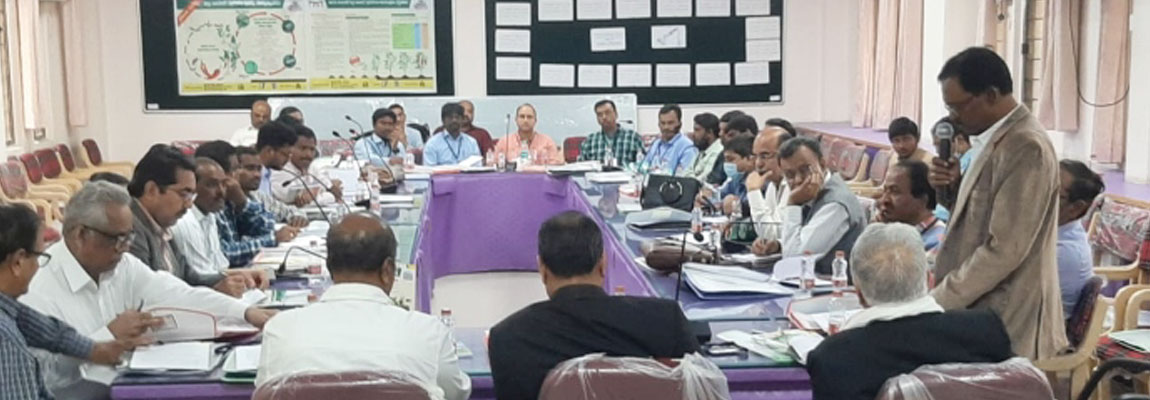
Technical Session I: Global Overview of Thrips parvispinus (Karny, 1922), An invasive pest
Technical Session I was chaired by Dr. K. S. Varaprasad, Ex Director, ICAR-IIOR Hyderabad.
Lead Speaker - I Dr. V. Sridhar, Principal Scientist (Entomology), ICAR-IIHR, Bengaluru delivered the talk on Global Overview of Thrips parvispinus (Karny, 1922), An Invasive pest.
Dr V Sridhar currently working as a Principal Scientist, Entomology, ICARIIHR. He has more than 16 years of research experience and expertise in Insecticide Resistance Management; Climate change and pests. He has studied Insecticide resistance in polyhouse populations of horticultural crop pests (mites on rose; thrips on rose and chilli and whiteflies on gerbera etc.) to commonly used pesticides. Baseline susceptibility data was also developed for various pests. He is a Fellow of Entomological Society of India – 2003 and received Young Scientist award from DST in 2004, also Associate Editor and Jt. Secretary, AAPMHE, Bangalore (Journal – Pest Management in Horticultural Ecosystems). Dr V Sridhar canbereachedatemail: sridhar.v@icar.gov.in
The talk emphasized on the following significant points:
- Recent outbreak of Thrips parvispinus from southern states of India (Andhra Pradesh, Karnataka and Telangana) especially on chilli crop caused 70-100 per cent damage.
- T. parvispinus, a member of “Thrips orientalis group”, is a widespread pest species of quarantine importance and thought to have originated from South- East Asia.
- T. parvispinus has displaced T. palmi in Indonesia indicating its competitive ability in displacement of other species in the chilli crop ecosystem.
- Taxonomic descriptions and typical identification key characters of T. parvispinus.
- In Chilli cropping system, farmers usually apply maximum number of sprays for sucking pest vector management. Still, T. parvispinus emerged as a concealed notorious pest to the chilli growers.
- Previously, researchers thought that T. parvispinus is a good pollinator, but congenial climate and continuous host availability contributed to its emergence as a key pest in chilli
- Host range of T. parvispinus including a crucial piece of information about its first-time record on Papaya in India during 2015.
- The damage symptoms on leaves are; distorted leaf lamina with necrotic areas and yellow streaking; on flowers include: brownish streaks on petals, drying and withering.
- T. parvispinus outbreak areas of Andhra Pradesh, Karnataka and Telangana with an observation of diminishing presence of the wellestablished other chilli thrips species, Scirtothrips dorsalis.
- Global distribution especially in Europe, its host range and level of damage
- Observation of black thrips epidemics in hot and humid conditions and its diminishing intensity after January.
- The male to female thrips ratio of 1:10- 15 contributing to proliferation of the pest.
- Mulching and soil enrichment with bio pesticides, neem cake would take care of the pupal stages.
- Black thrips are passive flyers however wind direction, velocity, continuous host availability and the presence of alternate hosts enhance the thrips migration capacity.
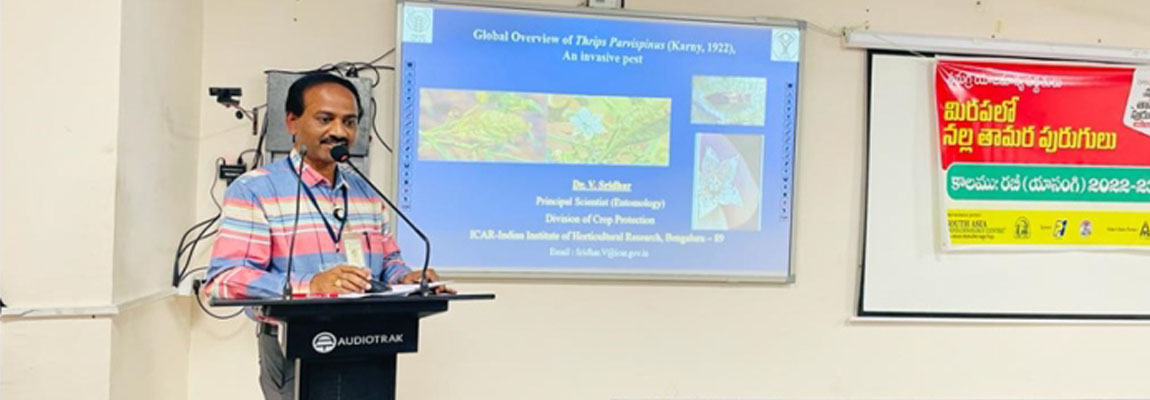
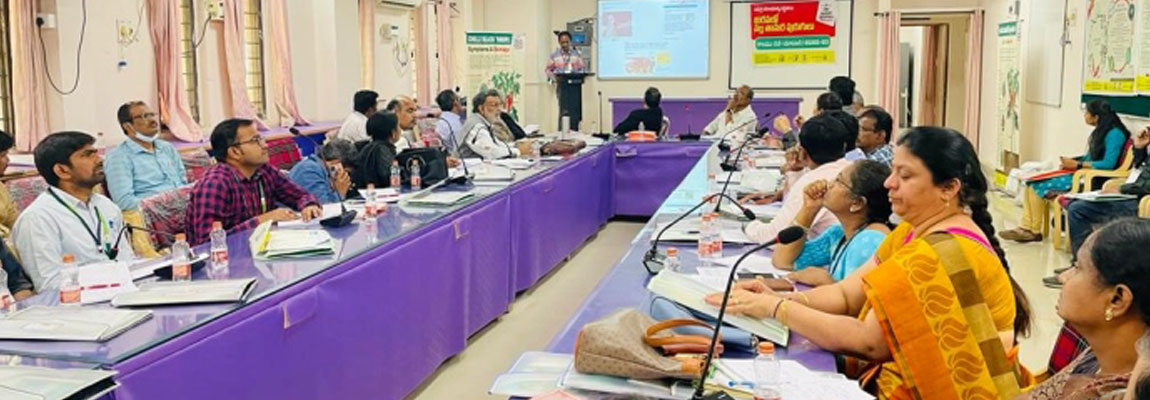
Presentation by Dr. Bhagirath Choudhary of Operation Nalla Tamara Purugu: Field demonstration, farmers engagement and scientific outreach
Dr Bhagirath Choudhary, Director, SABC spoke about the entire overview of the Black thrips scenario in the country and the work done by SABC as well as the concept note of the brainstorming session. Bhagirath Choudhary is the Founder Director of the South Asia Biotechnology Centre (SABC), New Delhi and has been leading the transfer of innovative technologies from the lab to the land. In last few years, he has been instrumental in devising and implementing projects to tackle the menace of invasive pests such as desert locust, fall armyworm and black thrips and endemic pest such as pink bollworm. He can be reached at email: bhagirath@sabc.asia
The following points emerged from his presentation.
- Invasive Black thrips or Thrips parvispinus (Karny), a polyphagous invasive pest of importance to chilli, papaya, eggplant & pepper was found for the first-time feeding on papaya in 2015 in Karnataka.
- Notably, the invasive Black thrips was reported in chilli growing areas of Andhra Pradesh, Telangana and Karnataka for the first time in Rabi 2021-22. From 2015, the pest was found feeding on both agriculture and horticulture including ornamental crops and widely distributed across Andhra Pradesh, Assam, Chhattisgarh, Gujarat, Karnataka, Kerala, Maharashtra, Odisha and Tamil Nadu.
- Black thrips, feeds on tender flowers, causes large scale shedding of flowers, stunting and malformation of fruits and fruit drop in chillies, leading to severe yield loss.
- In the absence of any approved and effective biological and chemical control, the pest caused significant damage & yield loss and considerably reduced quality and income of chilli growing farmers in AP, Telangana and Karnataka. As a result, the prices of chilli increased significantly taxing consumers and industry.
- A mega project “Operation Nalla Tamara Purugu (Black thrips in Chilli)” was launched by South Asia Biotechnology Centre with the support of PI Foundation and ITC Ltd to engage key stakeholders including scientists, researchers, extension officials and farming community, laying out field demonstrations and educating chilli growing farmers about IPM and quality production practices and value chain development in Guntur, Prakasam and Krishna districts of Andhra Pradesh, and Bhadradri Kothagudem, Mahabubabad & Khammam districts of Telangana. Operation Nalla Tamara Purugu has been organizing IPM field demonstration, intensive field-oriented training programs, creating knowledge resources and deploying new methods of cultural, microbials and innovative molecules to manage devastating black thrips in chilli in the priority chilli growing areas of Andhra Pradesh and Telangana in Rabi 2022-23.

Technical Session II: Pest surveillance, monitoring, identification and symptoms of damage of Thrips parvispinus in Chilli
Technical Session II was chaired by Dr T.V.K. Singh, Ex Dean, PJTSAU, Hyderabad.
Lead Presentation - I by Dr. Sree Latha on Pest surveillance, monitoring, identification and symptoms of damage of Thrips parvipsinus in chilli
Lead Speaker - I Dr. Sree Latha, Asst director, NIPHM, Hyderabad delivered the talk on Pest surveillance, monitoring, identification and symptoms of damage of Thrips parvispinus in Chilli. She shared her experience on survey, monitoring and collections made on black thrips in Andhra Pradesh and Telangana states.
Dr Sree Latha is currently working as Assistant director at NIPHM with 20 years of experience in Agriculture Research/ teaching. Expertise in Biological control, Host plant resistance, Organic farming and AESA. With also hands on experience
on farm production of bio-control agents, bio fertilizers and microbial bio-pesticides, Production protocol for predators and parasitoids, Bee Keeping for sustainable agriculture. Dr Sree Latha can be reached at email: sreelatha.e@gmail.com
The following important points/ recommendations emerged from the talk.
- Pest surveillance should be done as per the guidelines of International Standards for Phytosanitary Measures (ISPM) standards.
- Blue sticky traps are the best tools for monitoring as well as managing chilli black thrips at both nursery and field levels.
- Raised concern over inappropriate mixtures of chemicals including insecticides, microbials used at farmer's level.
- Database for forecasting and modelling the incidence of chilli black thrips is the need of hour.
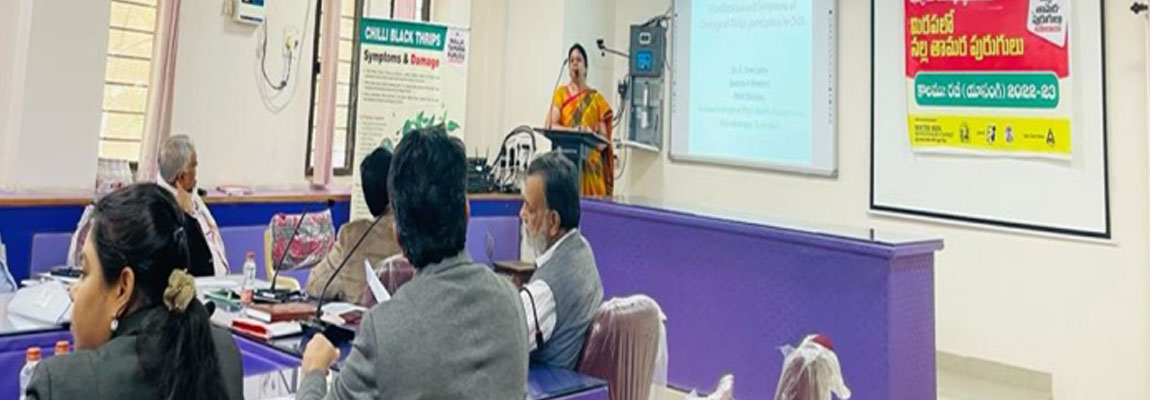
Lead Speaker - II Dr. D. Anitha Kumari, Senior Scientist SKLTSHU, Hyderabad delivered the talk on Innovative approaches, preparedness and field experiences of mitigating damage caused by Black thrips in Chilli growing areas of Telangana.
Dr D. Anitha Kumari is currently working as a Senior Scientist, VRS, SKLTSHU, Hyderabad. She holds Ph.D. Entomology from ANGRAU, Rajendranagar. She has 18 years of research experience of working on Vegetable, Tuber crops, Grapes, Mango and their pest management. She has published more than 50 research articles in diverse journals of International and national repute. Dr D Anitha can be reached at email: anithavenkat6@gmail.com
The following are the salient points from her talk based on a roving field survey in Telangana.
- Chilli crop transplanted during July was found free from incidence of black thrips, indicating the need for timely transplanting of chilli crop.
- Application of neem cake, neem oil and pongamia oil were found as promising botanicals for the management of black thrips.
- Combination of Entomopathogenic Nematode + Beauveria bassiana + Metarhizium anisopliae + Verticillium has shown good results in reducing adult population by infecting prepupa and pupal stages.
- Spraying of fipronil 80% WG @ 0.2 g/lit or cyantraniliprole @ 1.25 ml/lit or acetamaprid @ 0.2 g /lit or spinosad @ 0.3 ml/lit water as sequential sprays at weekly interval is recommended to effectively manage chilli black thrips.
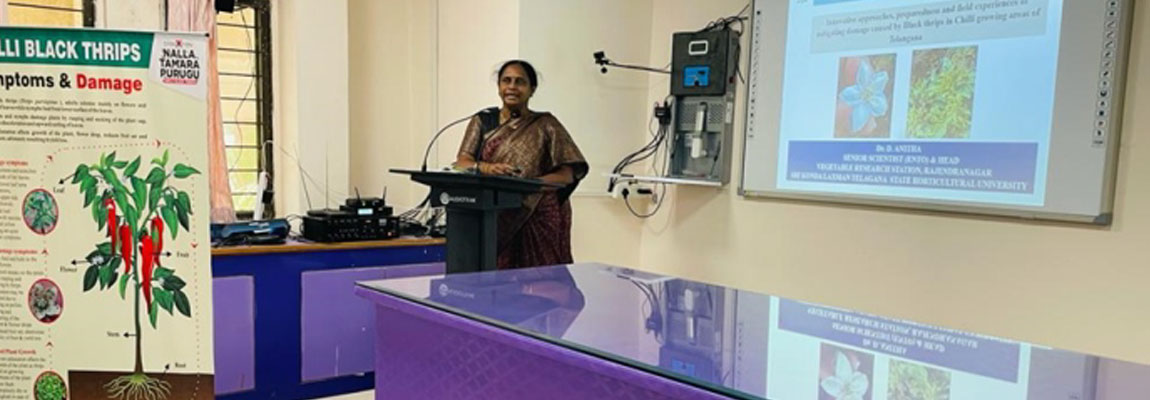
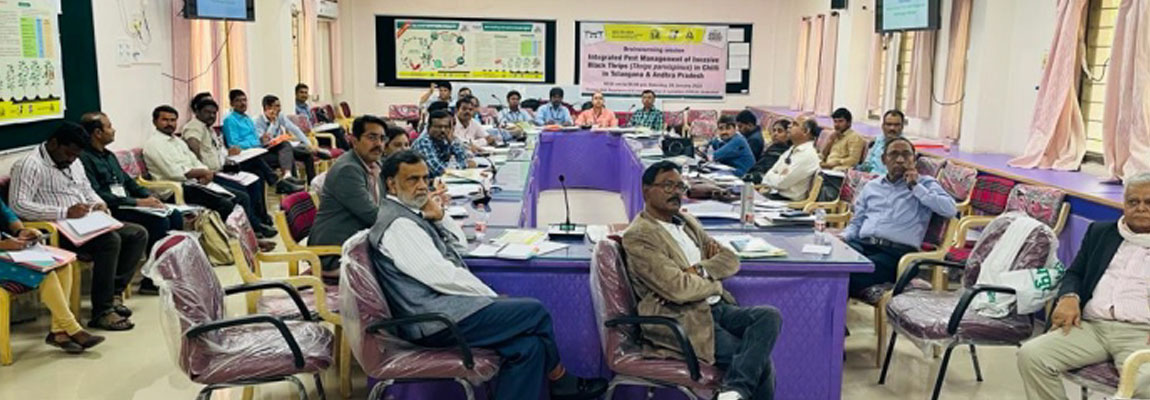
Technical Session III: Integrated pest management approaches of Invasive chilli Black thrips and ways forward
Technical Session III was chaired by Dr. Gururaj Katti, Principal Scientist (Entomology, Retd.), ICAR-IIRR, Hyderabad.
Special remarks by Mr. D.V. Rayudu, Ex-IAS,
working at Rythu Sadhikara Samstha
(RySS, A Government Corporation for
Farmers' Empowerment) shared the
experiences of RySS in AP with special
reference to integrated pest management
approaches of Invasive chilli black thrips
and ways forward.
He highlighted the
following features:
- The non-pesticide management practices to grow natural farming-based chilli in Andhra Pradesh state.
- Uniqueness of natural farming system and use of Neem seed kernel extract, Panchagavya and Dashaparni kashayam for the management of sucking pests in chilli ecosystem.
- Benefits of engaging community and self-help groups in managing the pest.
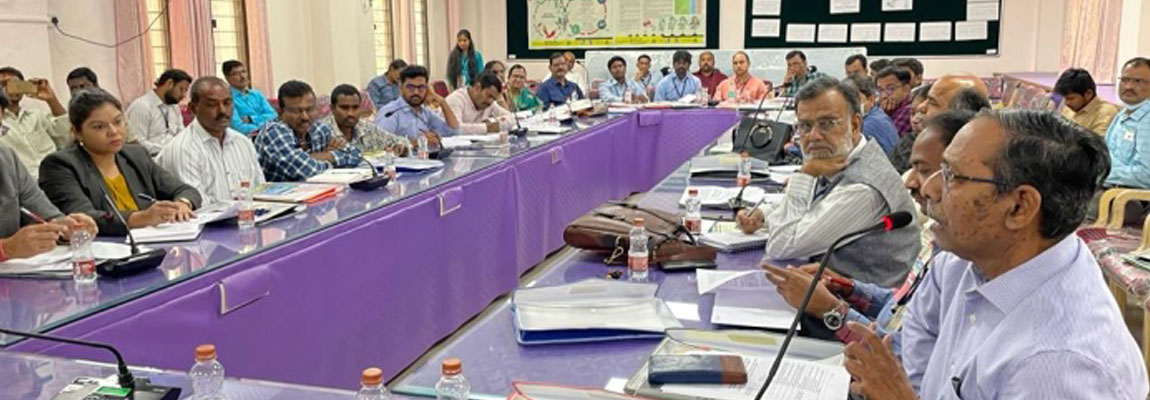
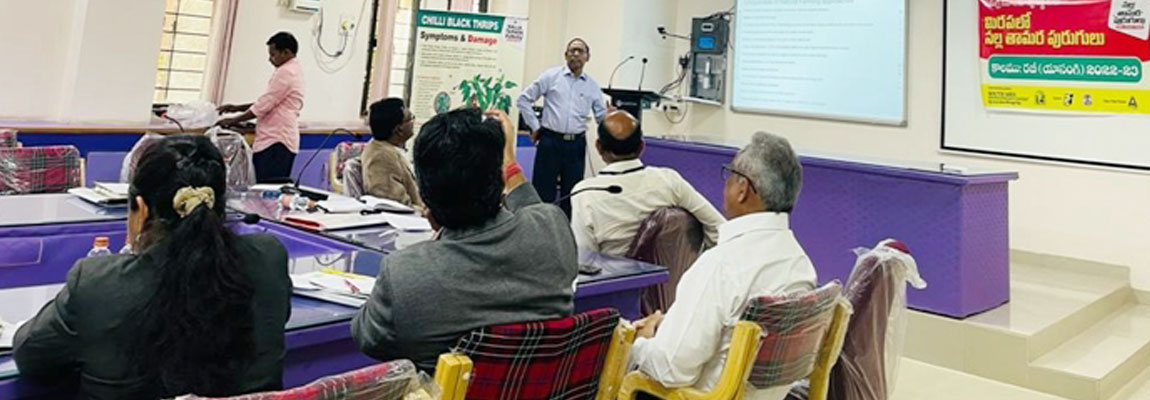
Lead Speaker - I by Dr. S.J. Rahman, the Dept. of Entomology, PJTSAU, Hyderabad delivered a lead presentation on Integrated pest management approaches focusing on biological interventions for the management of invasive chilli black thrips and ways forward.
Dr. S. J. Rahman is working as Professor & Head at Dept. of Entomology, College of Agriculture, PJTSAU, Hyderabad. Earlier he served as Associate Dean, College of Agriculture, Rajendranagar. He was the head for AICRP on Biological control of crop pests and weeds. Currently he is one of the expert members of Genetic Engineering Appraisal Committee
(GEAC), Ministry of Environment, Forest and Climate Change, Govt of India. Dr S J Rahman can be reached at email: sjrahman1964@rediffmail.com
Dr. Rahman emphasized upon:
- Short and long-term management practices for the control of black thrips.
- Cultural management practices like avoiding staggered sowing and provision of additional 2/3 irrigations in chilli crop to reduce the pupal counts and thereby the pest load.
- Nipping or destruction of infested apical shoots, uprooting of > 90% thrips infested crop, spraying of Azardirachtin 10000 ppm @ 1 ml//L and silver color mulching.
- Generating sufficient data on efficacy, safety and performance of chemical and bio pesticides to be submitted to CIBRC for expert verification.
- Prioritization of label claims and adhoc approval for appropriate chemicals and bio pesticides by CIBRC in the absence of recommended chemicals/bio pesticides against T. parvispinus
- Strict monitoring and confiscation of the spurious chemicals and appropriate measures to prevent the use of spurious products.
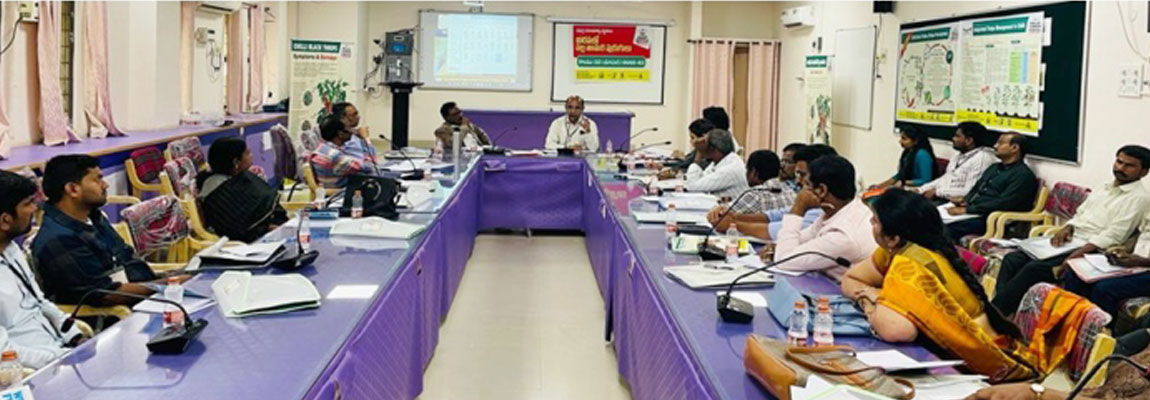
Three chilli farmers from different places viz., Guntur, Prakasam and Kakinada participated in the session and shared experiences of their natural farming practises for thrips management in chilli. Further they explained the composition and preparatory procedures for the various natural extracts being used for the management of chilli black thrips. During the ensuing discussion the practising farmers were suggested to further collect and generate adequate data for validation of the claims of efficacy of natural products for effective management of the invasive black thrip species.

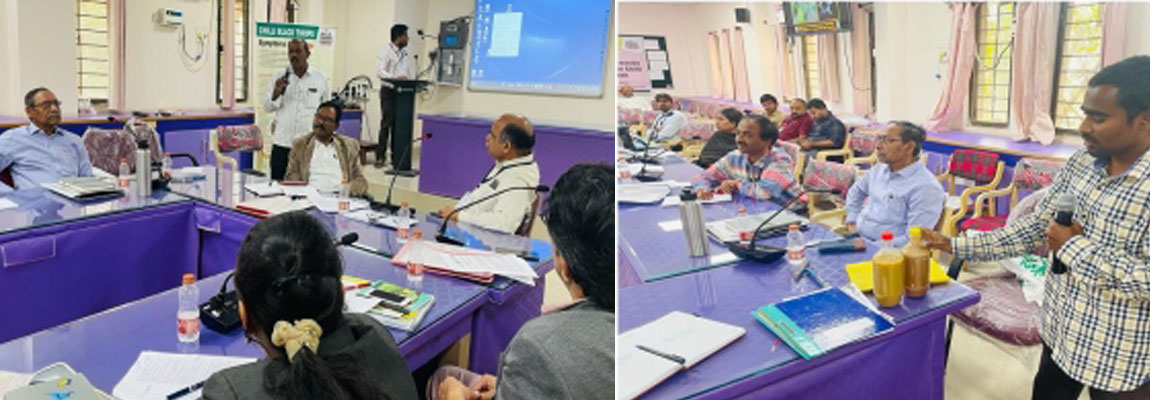
Panel Discussion With Private Organizations
During this session, the delegates from private agencies put forth their views and points for consideration:
MAHYCO:
Sh Kishore Kumar P and Sh Rudragouda M of Mahyco, Jalna, Maharashtra:
- Need for identification and evaluation of germplasm tolerant to chilli black thrips.
- Development of field-testing protocols for screening of chilli germplasm against black thrips.
- Coordination between different agencies such as research institutions, extension functionaries and regulatory systems involving private sector participation
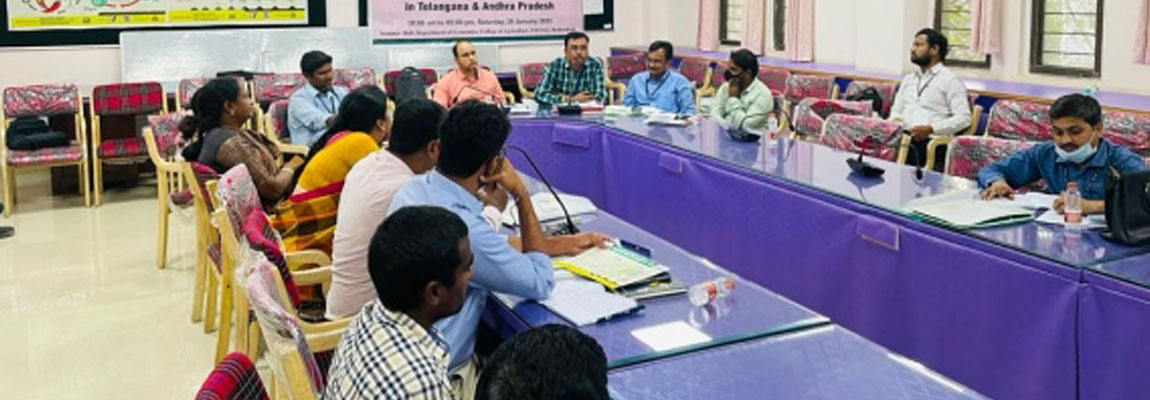
PI Industries:
Ms Gurpreet Kaur B, Crop manager of PI Industries, Gurgaon
- Complete IPM package for the management of chilli black thrips as the window of damage is very large in chilli cropping system.
- Standard IPM package of practices issued by appropriate government agency as information from multiple sources confuses the farmer.
- Prioritization for Screening of the existing/novel chemistry which is superior for effective tackling of the pest
- Rotation of insecticides with diverse mode of actions to avoid the insecticide resistance
- Development of SOPs for drone-based formulations
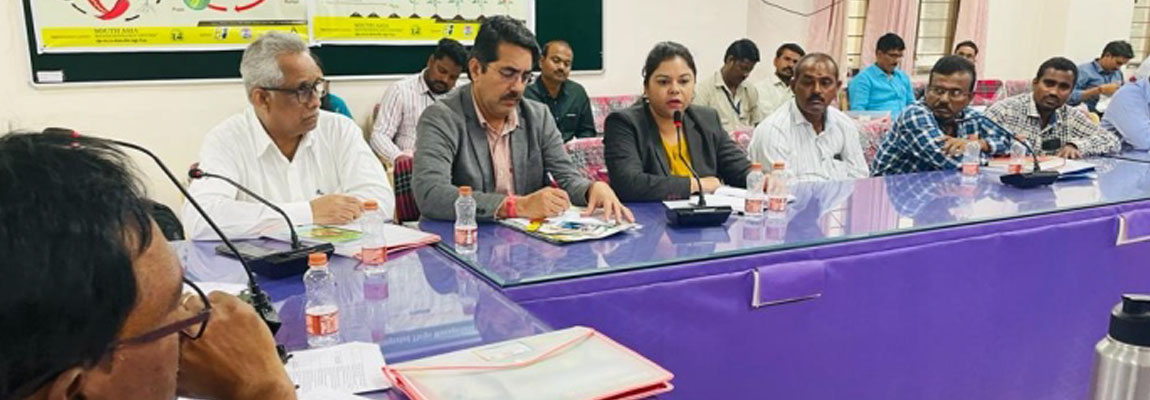
BASF:
Mr Pramod, Asst Manager of BASF India, Vijayawada
- Role of nutrition's viz., Potassium and micro nutrients in plant health management
- Importance of Irrigation and the preharvest interval in chilli thrip management.
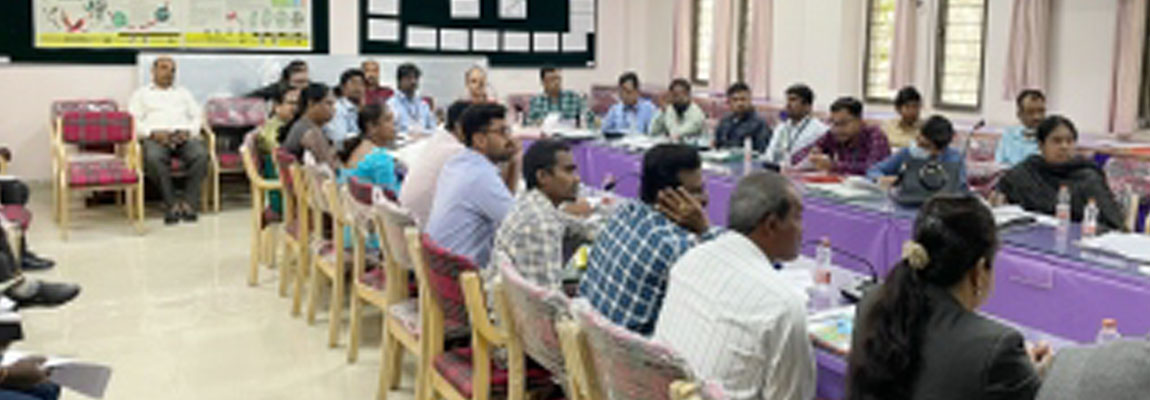
SAKATA:
Mr Lokesh Reddy Sama of Sakata Seeds, Bengaluru:
- Proper maintenance of the chilli crop to mitigate the losses caused by black thrips
- Need for clarifying the myths about resistant chilli genotypes to avoid confusion among the farmers.
WORLD VEGETABLE CENTRE:
Dr Manoj Kumar Nalla, Pepper breeder, Word Vegetable Centre, Hyderabad:
- Need for relook on the efficacy of various pesticides used to control chilli black thrips
- Avoiding generalized notions on the pest developing resistance to currently used pesticides
- Need to determine LD/LC50 values for pesticides that are being used against chilli black thrips
- A clear recommendation and strict compliance for sowing window of chilli crop to avoid staggered sowing
Concluding remarks by Chairman (Dr. Gururaj Katti):
Dr Gururaj Katti completed his Ph.D. (Entomology with specialization in Insect toxicology) in 1987 from Indian Agricultural Research Institute, New Delhi, India. He has served ICAR for 34 years and has research experience of 8 years on pulses and 26 years on rice crop. Dr. Katti superannuated as Principal Scientist (Entomology) and Head (Crop Protection) at the ICAR - Indian Institute of Rice Research (IIRR), Hyderabad, India. As, Principal Investigator (Entomology) he was the leader of the Entomology research programme during 2013 to 2020, under All India Coordinated Rice Improvement Project (AICRIP), spread across the country. Dr Katti is the key resource person for on farm IPM areas in all the IPM training programmes and he can be reached at email: gururajkatti@yahoo.com or gururajkatti59@gmail.com
- Intercrop, border and trap crops to be identified.
- Insecticidal schedules for chemical management and sticky traps for mass trapping and monitoring to be finalized through AICRP trials etc.
Concluding remarks by Chairman (Dr. TVK Singh):
Professor Emeritus and an experienced member with a demonstrated history of working in the government administration. Skilled in Life Sciences, Agriculture, Research, Public Speaking, and Teaching. Strong operations professional with a Doctor of Philosophy (Ph.D.) focused in Agricultural Entomology from Indian Agricultural Research Institute, New Delhi, India. His major expertise includes Integrated Pest Management, Insecticide Resistance management, Insect Ecology and crop protection. TVK Singh can be reached at his email id: prof.tvksingh@yahoo.com
- Resistance management studies should be thoroughly carried out
- Proper study and validation of multi coloured sticky traps to determine the number of traps, layout and for a structured installation in fields.
- Detailed and scientific investigation on replacement/displacement studies of S. dorsalis by T. parvispinus has happened or happening?
- Research on incidence and damage potential of chilli black thrips under protected cultivation
- Proper studies need to be carried out on microbial consortiums before field use.
Recommendations of Brainstorming Discussion on Chilli Black Thrips
A) Researchable issues
| 1. | Detailed research studies on biology, life cycle, reproduction, distribution and migratory habit of Black thrips |
| 2. | Incidence, diversity, competitiveness and replacement studies on the invasive species, Thrips parvispinus and existing species, Scirtothrips dorsalis |
| 3. | Field level determination of ETL/EIL and damage boundary for Black thrips |
| 4. | In depth investigations on effectiveness of botanicals, microbials and pesticides including field evaluation of mixtures/compatibility against chilli Black thrips |
| 5. | Evaluation of LC/LD50 values for the existing as well as new chemicals against Black thrips |
| 6. | Standardization and validation of trap parameters for Sticky traps such as color, size, number, geometry, pattern and structured installation in the field for both monitoring and mass trapping. |
| 7. | Evaluation of crop geometry, spacing, sowing dates and irrigation intervals along with inter/border/cover/trap crop to reduce incidence and damage levels of chilli Black thrips |
| 8. | Research studies on application of plant growth regulators and bio stimulants and their effect on thrips life cycle |
| 9. | Evaluation of landraces/germplasms for resistance to Black thrip and studies on Genotype × Environment interactions under the climate change scenario |
| 10. | Field studies on identification of R population to assess field acquired resistance |
B) Policy & regulatory recommendations
| 11. | Standardization of harmonized IPM package of practice and protocol for multiple control measures to be released based on localized research & field evidence on invasive Black thrips |
| 12. | Adhoc approval and label claim relaxation of existing and new chemistry based on globally available data and field experience immediate management of invasive Black thrips |
| 13. | Development of collaborative projects and exchange network programs on Black thrips with South-East Asian countries and World Vegetable Centre |
| 14. | Determination of PHI/Waiting period, MRLs and residual toxicity of existing/new chemicals against Black thrips |
| 15. | Standard Operating Procedures (SOPs) for drones-based applications like formulations, dose, spray volume, altitude etc. |
| 16. | Standard IPM package of practice and protocol for managing black thrips in green/poly houses/protected cultivation |
C) Scientific outreach
| 17. | Engagement of key stakeholders including scientists, researchers, extension officials and farming community, laying out field demonstrations and educating chilli growing farmers about IPM and quality production practices and value chain development |
| 18. | Encouragement of farmers participatory research including public, private and NGOs |
| 19. | E- pest surveillance with GIS and GPS for regular monitoring of incidence and issuing ETL based technical advisory for location specific management of Black thrips in chilli |
Acknowledgement
Foremost, we are grateful to PI Foundation for the project funding. We thank Dr Sarath Babu, PPAI, Hyderabad for hosting and leading the Brainstorming session. We thank all the keynote speakers, panellists and Chairmen for their contributions during the sessions. We acknowledge the efforts of rapporteurs - Dr Bhaskar Bajaru, Dr Prasanna & Dr Parameswari Balasubramaniam of ICAR-NBPGR Regional Station, Hyderabad Dr Sravan Kumar and Dr Narava Ramana of South Asia Biotechnology Centre, Jodhpur. for their meticulous session reports. We gratefully acknowledge the assistance and support from Department of Economics and the entire team of personnel from PJTSAU for smooth organization of the brainstorming session. Finally, we thank one and all stakeholders involved in the day long deliberations for their active participation and help in formulating a future roadmap for short and long-term management of this important invasive pest.
